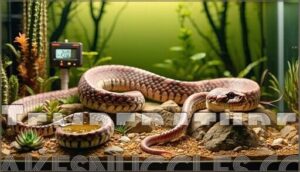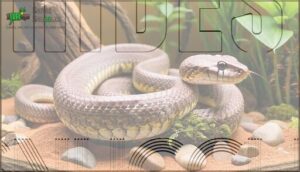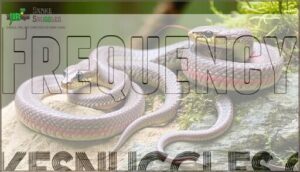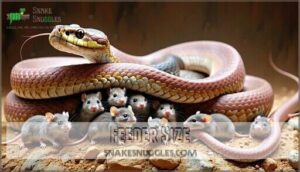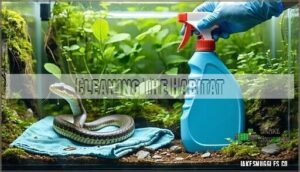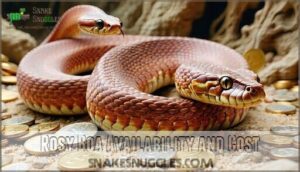This site is supported by our readers. We may earn a commission, at no cost to you, if you purchase through links.
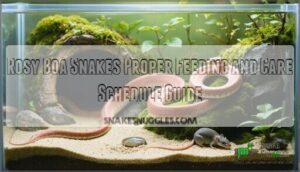
Keep their enclosure like a snug desert: a warm basking spot around 90°F, humidity below 50%, and always a hideaway for peace of mind. Spot clean daily, deep clean monthly, and use sanitized tools. That way, you’ll dodge the drama of mites or scale rot and give your friend a safe, happy home—just wait until you see what else keeps them in top shape!
Table Of Contents
- Key Takeaways
- Rosy Boa Overview
- Habitat Needs
- Feeding Schedules
- Cleaning The Habitat
- Health Issues to Avoid
- Rosy Boa Availability and Cost
- Frequently Asked Questions (FAQs)
- What is the ideal humidity level for a rosy boa enclosure?
- Should I provide a water bowl for my rosy boa?
- How can I tell if my rosy boa is shedding properly?
- What signs indicate my rosy boa may be sick?
- Can rosy boas be housed together or should they live alone?
- Do rosy boas require supplemental vitamins or minerals?
- What signs indicate a rosy boa is stressed?
- How can I tell if my rosy boa is dehydrated?
- Can rosy boas cohabit peacefully with other reptiles?
- Conclusion
Key Takeaways
- Feed hatchlings every 5–7 days and adults every 10–14 days, always sizing prey to your snake’s thickest body part.
- Keep the enclosure’s humidity below 50% and provide a basking spot around 90°F for a healthy, stress-free rosy boa.
- Spot clean waste daily, do a full deep clean every month, and always sanitize tools and décor to prevent disease.
- House your rosy boa alone, watch for sickness or stress signs, and handle gently and regularly—never during shedding.
Rosy Boa Overview
You’ll find the rosy boa (Lichanura trivirgata) makes an excellent beginner snake due to its docile temperament and manageable size requirements.
These native North American constrictors usually reach 2-3 feet in length and can live several decades with proper husbandry protocols.
Size and Age
Most rosy boas reach adult size between 24-36 inches, with growth rate slowing markedly after two years. Lifespan expectancy spans 20-30 years in captivity, making age indicators essential for proper feeding guide development.
Size variation between males and females affects prey selection requirements. Understanding your snake’s adult size helps determine appropriate feeding frequency and feeding techniques when feeding your rosy boa throughout its extended lifespan.
Handling Tips
Confidence forms the foundation of successful rosy boa interactions. You’ll want to support your snake with both hands, allowing it to explore freely across your palms. Never restrict movement or grip tightly—this triggers defensive responses. Wait 48 hours after feeding before any handling sessions. Children handling requires adult supervision for safety. Recognizing anxiety signs helps you adjust your approach appropriately.
Essential Handling Guidelines:
- Use gentle, calm movements to avoid startling your snake
- Support the entire body weight during handling sessions
- Allow natural exploration without forcing direction changes
- Maintain regular handling frequency (weekly) for socialization
- Practice safe restraint techniques to prevent injuries
- Avoid handling during shedding cycles completely
- Watch for stress indicators like rapid breathing
- Keep sessions brief initially (5-10 minutes maximum)
- Create quiet environments free from loud noises
Habitat Needs
You’ll need to create a proper habitat that mimics your rosy boa’s natural desert environment to keep them healthy and stress-free.
The right combination of substrate, temperature gradients, humidity levels, and hiding spots will make all the difference in your snake’s wellbeing.
Substrate
Choosing the right substrate creates a foundation for your rosy boa’s health. Bioactive setups with Terra Sahara substrate types mimic natural desert conditions while supporting burrowing behavior. These substrates maintain proper moisture levels in lower layers without affecting surface humidity.
You’ll need regular cleaning frequency schedules—spot clean weekly, replace substrate monthly to prevent bacterial growth.
Temperature
Your rosy boa needs precise temperature control to thrive. Create a thermal gradient with a basking spot at 90°F and ambient heat around 75-80°F on the cool side. Night temperatures can drop to 65-70°F naturally. Rosy boas thrive with low humidity levels.
Here are your heating guidelines:
- Use overhead halogen bulbs for naturalistic basking spot heating
- Maintain thermal gradient across the entire enclosure length
- Monitor both warm and cool zones with digital thermometers
- Cycle heating options off at night for natural temperature drop
- Adjust seasonal changes gradually to support natural brumation cycles
Temperature lighting should provide clear day/night cycles without disrupting your snake’s natural rhythms.
Humidity
Getting humidity levels right for your rosy boa isn’t rocket science, but it’s essential for preventing health problems. These desert natives thrive in specific humidity conditions that mirror their natural environment.
- Maintain ideal levels between 30-50% using a digital hygrometer for accurate monitoring
- Never exceed 60% long-term to prevent respiratory infections and skin problems
- Place water bowls on the cool side to minimize evaporation and humidity spikes
- Provide proper ventilation to prevent stagnant air that promotes bacterial growth
Humidity monitoring becomes especially important during shedding cycles when your snake needs slightly higher moisture levels temporarily. Watch for shedding problems like retained skin, which often indicates improper humidity needs aren’t being met. Knowing the proper care is essential, as captive-bred boas can live up to 60 years.
Heating and humidity work together – avoid placing water sources near heat elements as this creates dangerous humidity spikes. Water and hydration requirements can be met through proper bowl placement and occasional misting during shed cycles. Increasing humidity should only be temporary and targeted to specific areas rather than the entire enclosure.
Hides
Your rosy boa needs secure hides for comfort and thermoregulation. Place two hiding houses diagonally across the enclosure—one warm-side, one cool-side. Size matters: each hide should accommodate your snake’s length while feeling snug.
Multiple hides prevent stress and support natural behaviors. Use appropriate hide material like wood or plastic caves. Clean hides monthly during deep cleaning. These burrows become essential hiding places in your rosy boa care routine.
Feeding Schedules
You’ll need to establish a consistent feeding schedule that matches your rosy boa’s age and metabolism to maintain ideal health. **The frequency you feed directly impacts your snake’s growth rate, body condition, and overall wellbeing throughout its lifespan.
Frequency
Most snake owners find that establishing the right feeding frequency prevents health issues down the road. Your rosy boa’s age determines how often you’ll offer meals, with younger snakes requiring more frequent feeding schedules than adults.
Here’s your feeding routine breakdown:
- Hatchlings need meals every 5-7 days to support rapid growth during their first year
- Juveniles move to weekly feeding schedules as they approach adult size
- Adult schedules shift to every 10-14 days once metabolism naturally slows
- Seasonal adjustments may require feeding pauses during cooler winter months
Juvenile schedules shouldn’t worry you if your snake occasionally refuses food. Adult schedules allow for natural fasting periods that can last several weeks without concern. Remember that feeding your rosy boa consistently matters more than strict timing. These feeding guidelines help you establish a healthy feeding routine while recognizing that refusal reasons often include shedding cycles or environmental changes.
Prey Items
Frozen-thawed prey items form the cornerstone of ideal rosy boa nutrition. You’ll primarily feed mice—pinkies for hatchlings, fuzzies for juveniles, and hoppers for adults. Frozen vs live debate favors frozen-thawed prey for safety reasons, eliminating bite risks.
Multiple prey types like quail or Reptilinks can provide dietary variety, though mice remain the preferred choice. Your feeding schedule should match prey size to your snake’s girth for proper nutrition.
Feeder Size
Once you’ve selected appropriate prey items, feeder size becomes your next consideration. Proper sizing prevents regurgitation causes and obesity risks while supporting healthy growth.
- Match prey width to your snake’s thickest body section – never exceed 1.5x this measurement
- Calculate feeding portions at 10-15% of total snake weight for ideal nutrition
- Progress from pinkie mice (hatchlings) to small adult mice (mature specimens)
Monitor your snake’s response to each feeding schedule adjustment, watching for signs of strain or incomplete digestion.
Cleaning The Habitat
You’ll need to maintain proper sanitation protocols to prevent bacterial growth and parasitic infections that can compromise your rosy boa’s health.
Regular habitat maintenance involves both spot cleaning waste immediately and performing thorough deep cleaning sessions monthly to guarantee favorable environmental conditions.
Spot Cleaning
Daily waste removal keeps your rosy boa’s habitat clean and prevents odor control issues. Check substrate health by removing feces and urates immediately after feeding your rosy boa. Tool sanitation matters—clean tweezers and spot-cleaning supplies after each use.
Frequency impact shows: consistent daily cleanup maintains better substrate health than sporadic cleaning, supporting your snake’s feeding routine and overall dietary needs.
Deep Cleaning
When monthly deep cleaning becomes essential for ideal Rosy Boa Care, complete disinfection prevents disease transmission. Remove all tank contents first. Apply a 10% bleach solution for enclosure sterilization, ensuring thorough coverage. Wait thirty minutes before rinsing completely. Replace substrate entirely for effective parasite prevention.
Essential bioactive cleaning steps include:
- Temperature and humidity equipment sterilization
- Complete substrate replacement with fresh material
- Sanitizing all décor through dishwasher cycles
- Tank surface inspection for damage or wear
This thorough approach maintains your snake’s health long-term.
Health Issues to Avoid
Keeping your rosy boa healthy means staying ahead of potential health issues that can derail their well-being. Respiratory infections top the list of concerns, especially when humidity exceeds 50% or temperatures fluctuate frequently. Watch for wheezing, mucus discharge, and labored breathing—bacterial pathogens cause over 95% of these infections.
Scale rot develops in damp conditions, while dermatophytosis (fungal skin infections) thrives in poorly maintained enclosures. Cryptosporidiosis, a serious parasitic infection, can cause chronic digestive problems and weight loss. Mite infestations appear as tiny dark spots and trigger excessive soaking behavior.
Preventative care is your best defense: maintain stable temperatures, keep humidity below 40%, and perform regular checks of your snake’s skin, breathing patterns, and appetite. Early detection makes treatment more effective, while proper habitat hygiene prevents most issues from developing in the first place.
Proper habitat conditions and regular health monitoring prevent most rosy boa diseases before they start
Rosy Boa Availability and Cost
Finding your perfect rosy boa requires exploring the Reptile Hobby landscape. Standard rosy boa hatchlings cost $189-$350, while rare Morph Prices reach $500-$2,000 for designer genetics like Snowwhite or Paradox varieties. Wild-Caught specimens aren’t recommended; captive-bred animals from reputable sources are safer investments.
Breeder Reputation matters tremendously for Ethical Sourcing. Research breeders’ health guarantees and lineage documentation. Peak availability runs August through October when hatchlings emerge. Shipping costs $44-$65 nationwide for overnight delivery.
Remember, Buying and Keeping Rosy Boas involves Long-Term Costs beyond initial purchase—housing, heating, and feeding requirements for up to 30 years. This Long-Term Commitment in the reptile world requires careful budgeting. Examine Pricing and Varieties thoroughly, as investment-grade morphs can appreciate substantially over time.
Frequently Asked Questions (FAQs)
What is the ideal humidity level for a rosy boa enclosure?
Imagine your rosy boa lounging in a desert spa—aim for enclosure humidity under 50%. Too much moisture invites trouble, like scale rot.
A digital hygrometer gives you solid numbers, keeping your pet safe and thriving.
Should I provide a water bowl for my rosy boa?
Absolutely—your rosy boa needs a water bowl. Keep it clean and filled with fresh water at all times.
It’s not just for drinking; they may soak or even push it around for fun!
How can I tell if my rosy boa is shedding properly?
Check your rosy boa’s eyes, belly, and tail for dullness or cloudy patches—signs it’s entering shed. **If the old skin peels off in one piece, you’re golden; patchy sheds hint at low humidity or dehydration.
What signs indicate my rosy boa may be sick?
Like a silent alarm, warning signs—lethargy, wheezing, scales that darken or shed poorly, and unexplained lumps—mean your rosy boa may be sick.
If your snake starts skipping meals or hiding more, contact a reptile vet.
Can rosy boas be housed together or should they live alone?
It’s best to keep rosy boas solo. Housing them together often leads to stress, competition, or even injury. These snakes are like introverts at a party—happier and healthier on their own, with no roommates.
Do rosy boas require supplemental vitamins or minerals?
You don’t need to add extra vitamins or minerals if you’re feeding whole, properly sized mice. **Each mouse is pretty much a “one-stop-shop” for nutrition.
Over-supplementing can even cause problems—so skip the snake shakes.
What signs indicate a rosy boa is stressed?
If your rosy boa is hiding a lot, refusing food, breathing rapidly, or hissing more than usual, it’s waving a little red flag. Stressed snakes may also rub their noses or show wrinkled, dull skin.
How can I tell if my rosy boa is dehydrated?
Sure, your snake obviously prefers raisin skin, right? But if its eyes look wrinkled, skin feels loose, or it stops shedding cleanly, dehydration is likely.
Always provide fresh water and watch for signs of lethargy.
Can rosy boas cohabit peacefully with other reptiles?
It’s not a good idea to house your rosy boa with other reptiles. They prefer solitude and can get stressed or injured if forced to share space. Think of them as introverts—they thrive best alone.
Conclusion
Balance clinical care with consistent fun—rosy boa snakes’ proper feeding and care schedule makes the difference between a thriving pet and a stressed reptile. Feed hatchlings more frequently, stick to a cleaning timetable, and keep environmental variables steady.
Use evidence-based schedules for longevity and fewer vet trips. Ignore myths; stick to what’s proven. With routine, you’ll enjoy a calm, healthy snake instead of a moody escape artist. **Your consistent attention delivers the very best results.
- https://www.reddit.com/r/snakes/comments/1aoeb8d/i_just_lost_my_fiance_i_need_to_know_how_to_take/
- https://www.rosyboamorphs.com/thanksgiving-giveaway
- https://dubiaroaches.com/blogs/snake-care/rosy-boa-care-sheet
- https://reptilesmagazine.com/rosy-boa-care-sheet/
- https://www.scalybabies.com/rosy-boa-care


